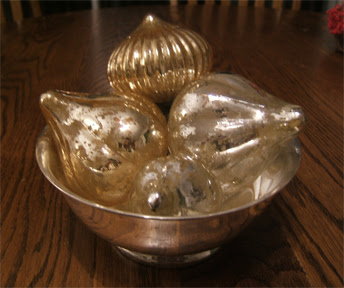

I polished some silver last night, bowls that my dad used to pick up for me at second-hand stores when he was still out and about. Then I got the pretty, antique-looking Christmas balls and put them in the bowls, and thought I'd take some pictures, intending to play with depth-of-field. Turned out the pictures were harder to take than I expected since the light was poor in the diningroom at night, so I thought I'd play with them in Photoshop this morning. I had some notes scribbled in the back of one of my Photoshop books about the 'Orton Effect,' which is what I attempted here.
This effect is named after a photographer named Michael Orton who developed it as a darkroom technique long before digital imaging; it's much easier to mimic the effect inside digital photo-editing programs.
BE CAREFUL NOT TO DESTROY YOUR ORIGINAL IMAGE!
1. Open your original image. Duplicate this layer. Change the blending mode of the new, upper layer to "screen" and merge these two layers.
2. Duplicate this new layer. Change the blending mode to "multiply."
3. Making sure that the top layer (the one set to "multiply") is selected, choose Filter>Blur>Gaussian Blur. You can play with the amount of the blur, watching your preview window. I think for this image I chose somewhere around a 7 pixel blur for a 72 dpi, 4" x 4.8" image. How much you blur will depend on the resolution and size of your image. In general, you want to blur enough to remove the detail from the upper "multiply" layer.
For this particular image, I also removed some of the distracting pieces of the image (the chair backs and the red flower) and blurred the wood grain in the table a little bit extra...
Any questions or comments, let me know...

2 comments:
It's beautiful.
For low light photography I use a tripod (about $15) and put the camera on a food setting (or something similar that will keep the shutter open), frame up your picture and then (and here's the secret) set the self portrait timer for 2-10 seconds so that everything will be completely still.
See I took this picture a few moments ago in that manner.
http://www.ssb4.net/users/27769/l1040597.jpg
Do you ever think about giving classes in YOUR studio?
Post a Comment